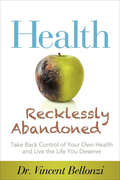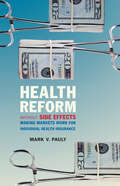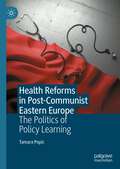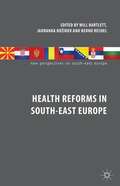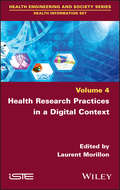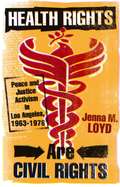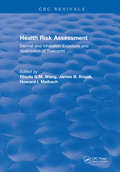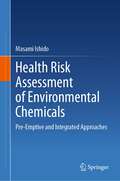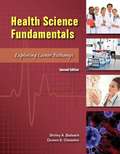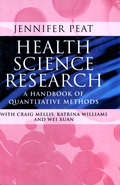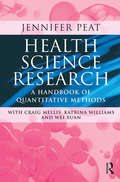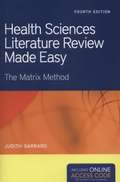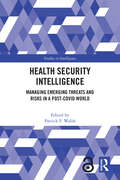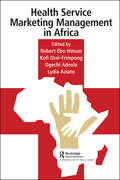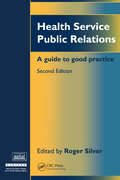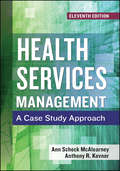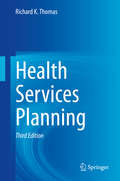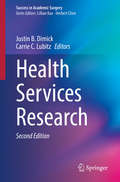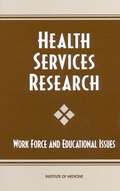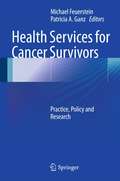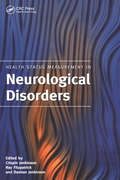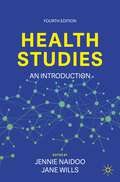- Table View
- List View
Health Recklessly Abandoned: Take Back Control of Your Own Health and Live the Life You Deserve
by Vincent BellonziHealth, Recklessly Abandoned describes a new paradigm when it comes to thinking about health and wellness. Health is truly a state of being self-sufficient from health-care. Prevention is referring to not allowing disease to begin in the first place, as opposed to simply finding something early in development. Functional medicine describes how a human body working correctly does not suffer disease. Science is proving that how you live your life, determines the quality of that life. The human body does not make mistakes, it is simply responding to the lifestyle that you subject it to. Eat genuine foods, and get a healthy response. Eat processed food substances, and often you get an inflammatory response.It is as if the human body knows what will be beneficial, as opposed to what will cause dysfunction. If you want your body to work properly then you must use its’ adaptive abilities correctly. When you are physically active, the body responds with better neural networks, better energy production, better hormone balance and in general better working of all the biological systems that make the body function. When your activity level decreases, and you consume primarily processed, convenience foods, then the body tends to proceed in the direction of degeneration. If you let this go on too long, then dysfunction becomes disease. At this point there is a need for health care interventions. Evolution is supposed to be a positive progression, allowing an increased chance for survival of an animal that is better suited for life in the present. Without realizing it, many humans are progressing backwards and “de-evolving” toward a weaker creature with less ability to thrive. Join with the author and learn to EVOLVE. There is a way to keep the body biologically, physiologically and metabolically young, well beyond the accumulation of years.
Health Records in Court
by Jane Lynch Topsy MurrayThis book is an essential tool for all healthcare professionals. An understanding of the law and the way in which it impacts upon roles, responsibilities and care is a vital component in everyday healthcare. Written in a clear and concise style, Health Records in Court provides practical legal advice by highlighting real-life healthcare case studies and workplace examples. It offers much-needed, clearly explained guidance for navigating the complexities and intricacies of medico-legal processes, practices and obligations - vital for every health professional who creates, adds to or maintains health records.
Health Reform without Side Effects: Making Markets Work for Individual Health Insurance
by Mark V. PaulyMark V. Pauly offers a detailed look at the individual insurance market in the United States. He explains how it works, suggests approaches to improvement that build on what currently works well, and provides a realistic assessment of how much improvement we can demand and expect. He concludes that, although there are some serious deficiencies in today's individual insurance market, there are also some important advantages in this market that should be preserved.
Health Reforms in Post-Communist Eastern Europe: The Politics of Policy Learning
by Tamara PopicThis book provides the first in-depth study of healthcare reforms in post-communist Eastern Europe. Combining insights from comparative politics and public policy analysis, it examines health reforms in Slovenia, the Czech Republic, and Poland between 1989 and 2019. The book argues that the post-communist transformation of healthcare policy has entailed a process of policy learning, and that the countries' reform pathways were shaped by a series of initiatives aimed at applying market-oriented policy ideas in healthcare. The success of these initiatives has been influenced by three factors: policy legacies, political competition, and institutional configurations. The book offers a novel comparison of health reform in the region and policy changes more generally. It will appeal to scholars and students of public policy, health policy, and European politics.
Health Reforms in South East Europe
by Will Bartlett Jadranka Božikov Bernd RechelOver the last two decades the countries of South East Europe have engaged in far-reaching reforms of their health systems. However, overviews of reform efforts in this part of Europe have been sorely lacking. This book addresses this shortage through the analysis of key aspects of health reforms and health workforce mobility in South East Europe.
Health Research Practices in a Digital Context
by Laurent MorillonThe current “generalized digitization” of society is influencing the health environment, healthcare organizations as well as actors. In this context, human and social sciences deconstruct, nuance and sometimes even challenge certain preconceived ideas and/or dominant discourses. In this book, researchers of four nationalities and three different disciplines have agreed to open the “black box” of their work. They display their scientific practices from the perspective of epistemology, ethics and methodology. They present and analyze their values and postulates but, also, what may have influenced the project, the definition of the object and objectives, as well as their approaches. In a contextual way, the first part presents some changes in environments and infocommunicational practices related to digital health. The second part opens space to reflect on ethics and deontology. Finally, postulating that scientific fact is not an essence but the result of a process, the last part discusses the methods implemented, which may be different from those initially envisaged. This book is dedicated to the researchers and postgraduate students in the human and social sciences as well as the health practitioners likely to collaborate with them.
Health Research in Nigeria: A Bibliometric Analysis
by Joseph Abiodun BalogunThis book is the first authoritative study of the research output and scientific impact of Nigerian health academics, including those in the diaspora. Around the world, policymakers and academics measure the scientific impact of research at national and international levels using bibliometric measures. Unfortunately, there is limited data on scientists' research productivity and impact in developing countries, particularly in Africa. Therefore, normative bibliometric information from different countries is needed to address the challenges faced by scientists in Africa. This book contributes to filling this research gap. Additionally, the author addresses the controversies surrounding the use of bibliometrics in judging research productivity and offers recommendations to improve research systems.
Health Rights Are Civil Rights: Peace and Justice Activism in Los Angeles, 1963–1978
by Jenna M. LoydHealth Rights Are Civil Rights tells the story of the important place of health in struggles for social change in Los Angeles in the 1960s and 1970s. Jenna M. Loyd describes how Black freedom, antiwar, welfare rights, and women&’s movement activists formed alliances to battle oppressive health systems and structural violence, working to establish the principle that health is a right. For a time—with President Nixon, big business, and organized labor in agreement on national health insurance—even universal health care seemed a real possibility.Health Rights Are Civil Rights documents what many Los Angeles activists recognized: that militarization was in part responsible for the inequalities in American cities. This challenging new reading of suburban white flight explores how racial conflicts transpired across a Southland landscape shaped by defense spending. While the war in Vietnam constrained social spending, the New Right gained strength by seizing on the racialized and gendered politics of urban crisis to resist urban reinvestment and social programs. Recapturing a little-known current of the era&’s activism, Loyd uses an intersectional approach to show why this diverse group of activists believed that democratic health care and ending war making were essential to create cities of freedom, peace, and social justice—a vision that goes unanswered still today.
Health Risk Assessment Dermal and Inhalation Exposure and Absorption of Toxicants (CRC Press Revivals)
by Howard I. Maibach Rhoda G.M. Wang James B. KnaakHealth Risk Assessment is a comprehensive reference focusing on dermal absorption, cholinesterase inhibition, adverse reproductive effects, and carcinogenicity. The book features contributions from over 40 top scientists and covers topics such as PBPK modeling, cytochrome P-450 metabolism in skin, percutaneous absorption, adverse effects, new skin models, and the role of epidemiology in assessing the hazards of toxicants. Health Risk Assessment is essential for toxicologists, environmental chemists, pharmacologists, risk assessors, and managers working in industrial, pesticide, and pharmaceutical development. The book will also benefit individuals in environmental, regulatory, and registration affairs, as well as academicians and students.
Health Risk Assessment of Environmental Chemicals: Pre-Emptive and Integrated Approaches
by Masami IshidoThis book presents the frontier research of toxicology and health risk assessment of chemicals. First, it provides an overview of the current methods of evaluating safety amounts of chemicals and provides a new aspect of the principle of toxicology. Secondly, it shows recent research where the new method of health risk evaluation is adopted, followed by an integrated health risk assessment of chemicals. Finally, it describes the epigenetic inheritance of chemical impact on health throughout several generations. Estimating the safety amount of chemicals surrounding our lives is not sufficient for health risk evaluation, particularly for carcinogenic compounds, endocrine disruptors, and nano materials. The author’s group has found a family of chemicals linked to ADHD through animal screening and identified its chemical nature using chemoinformatics methods. Based on these new developments, this book proposes to utilize the biomarker common to those chemicals for health risk assessment, independent of exposure routes and physiological dimensions. The book appeals to researchers and students in the field of toxicology, health risk assessment, pharmacology, and public health.
Health Science Fundamentals (2nd Edition): Exploring Career Pathways
by Shirley A. Badasch Doreen S. Chesebro<p>Health Science Fundamentals: Exploring Career Pathways provides students with the skills they need to become competent and productive health care workers throughout their careers, with a strong emphasis on employability skills such as teamwork, effective communication, and ethics. All-new photos, a new layout, and hands-on activities keep students engaged and involved in the material. To prepare readers for the job market today, the careers chapter is realigned to meet the Common Career Technical Core pathways and the Math, Science, and Language Arts Links are correlated to curriculum standards. <p>Health Science Fundamentals is divided into two parts to foster career skills. The first part, Becoming a Health Care Worker, includes basic information all health care workers must have to attain success in any health care field. The second part, Health Care Knowledge and Skills, covers the technical concepts and clinical skills students need to gain employability in a variety of entry-level occupations.</p>
Health Science Research: A Handbook of Quantitative Methods
by Jennifer PeatFor research to be effective, it is essential that every aspect of the study is well planned. Health Science Research has been written to help researchers from all disciplines conduct their studies with this kind of integrity. Each chapter covers a specific area fo conducting a study, including: - formulating the research question - preparing a grant application - subject recruitment - data collection and analysis - interpreting the results of the study This informative text is designed to be a user friendly research, reference and study tool. It has been organised into eight chapters, each of which covers a specific area of conducting a research study. This book will be of particular value to scientists, research assistants, qualified or trainee physicians, nurses and allied health workers. The book will also be an essential companion for students in all disciplines who want to learn more about how to do good research.
Health Science Research: A handbook of quantitative methods
by Wei Xuan Craig Mellis Katrina Williams Jennifer K PeatThis is an excellent book, which will be of value to all those health professionals seeking to demystify the sometimes intimidating area of research. Well organised, comprehensive, and clearly written, it is indeed a 'handbook'; it has a clear, step by step approach with many practical examples. It is suitable for researchers across the range of health disciplines, and the authors are to be congratulated for what will become an important resource.Professor Frank Oberklaid, Director, Centre for Community Child HealthUniversity of Melbourne/Royal Children's HospitalThis book will clearly be a great help to young, and to some extent, experienced research workers focusing on epidemiological and clinical questions framed either in terms of the broad community or patient groups. I recommend it warmly.Professor Stephen Leeder, Dean, Faculty of Medicine, University of SydneyHigh quality clinical research is a cornerstone of effective health care and much good research is undertaken by clinicians. Yet many of the resources available on research methods are highly theoretical and inaccessible.Written in a user-friendly style by a team of experienced clinical researchers, Health Science Research guides readers through the fundamentals of clinical inquiry. It outlines the steps needed to plan a study, recruit and select subjects, gather and analyse data, and report on results. The authors also explain how to deal ethically with interviewees, and how to prepare a grant application.Health Science Research is an indispensable guide for anyone who needs to undertake a clinical study, including physicians, nurses, allied health workers, scientists and research assistants.Jennifer Peat is Hospital Statistician in the Clinical Epidemiology Unit at the New Children's Hospital, Westmead, and Associate Professor in the Department of Paediatrics and Child Health at the University of Sydney. Katrina Williams and Professor Craig Mellis are from the same Hospital and Department, and Wei Xuan is from the Department of Medicine, University of Sydney.
Health Sciences Literature Review Made Easy: The Matrix Method (Fourth Edition )
by Judith GarrardHealth Sciences Literature Review Made Easy, Fourth Edition is an essential text for your nursing research course and provides students with a solid foundation and the tools they need to evaluate articles and research effectively. The Fourth Edition builds on the digital updates made to the previous edition and highlights the Matrix Method and the skills necessary to critically evaluate articles. The text also covers Method Maps, which teach students how to effectively construct a research study. The author leads students through the process of how to manage a quality literature review in the context of evidence-based practice. A case study highlighting a typical graduate student is woven throughout the text to illustrate the importance of literature reviews and evidence-based practice. Health Sciences Literature Review Made Easy, Fourth Edition is appropriate for graduate level nursing courses as well as undergraduate Nursing Research courses that require literature reviews. Key Features: • Data Visualization: A Digital Exploration is an interactive, online appendix • The Matrix Method teaches the essential skills around literature evaluation • A real-life scenario case study is woven throughout each chapter to reinforce key concepts • Completely updated chapter on the guidelines for Methodological Review • Method Maps are introduced to convey the thought process around designing a research study
Health Security Intelligence: Managing Emerging Threats and Risks in a Post-Covid World (Studies in Intelligence)
by Patrick F WalshThe book takes a multi-disciplinary approach to explore the role national security intelligence agencies played in supporting national governments’ response to COVID-19.Spanning the ‘Five Eyes’ intelligence countries (UK, USA, Canada, Australia and New Zealand), this book offers the first cross-comparative analysis of what intelligence agencies need to focus on in responding more effectively to future emerging health and biological security threats risks and hazards post-COVID-19. The volume addresses three principal issues. First, it investigates what roles the Five Eyes intelligence communities played (along with other key stakeholders, such as public health agencies) in managing the COVID-19 pandemic. Second, it assesses the challenges of and lessons learnt from these intelligence communities’ engagement in managing aspects of the pandemic. Third, it explores how the Five Eyes might play more effective roles in managing future health security threats and risks, whether those are intentional (bioterrorism and bio crimes), accidental (laboratory releases) or unintentional (pandemics) in origin. Overall, this book offers a coherent and holistic research agenda that seeks to improve understanding about the role of national security intelligence in managing health security threats and risks post-COVID-19.This book will be of much interest to students of intelligence studies, health security, public health and International Relations.The Open Access version of this book, available at http://www.taylorfrancis.com, has been made available under a Creative Commons Attribution-Non Commercial-No Derivatives (CC-BY-NC-ND) 4.0 license.
Health Service Marketing Management in Africa
by Robert Ebo Hinson Kofi Osei-Frimpong Ogechi Adeola Lydia AziatoHealth Service Marketing Management in Africa (978-0-429-40085-8, K402492) Shelving Guide: Business & Management / Marketing Management The application of marketing to healthcare is a fascinating field that will likely have more impact on society than any other field of marketing. It’s been theorized that an intrinsically unstable environment characterizes this very relevant emerging field, hence raising new questions. Changing regulations, discoveries, and new health treatments continuously appear and give rise to such questions. Advancements in technology not only improve healthcare delivery systems but also provide avenues for customers to seek information regarding their health conditions and influence their participatory behaviors or changing roles in the service delivery. Increasingly, there is a shift from a doctor-led approach to a more patient-centered approach. In Africa, the importance of marketing-driven practices in improving the delivery of healthcare services cannot be overemphasized. The issue of healthcare delivery and management is significant for policymakers, private sector players, and consumers of health-related services in developing economy contexts. Scholars have strongly argued in favor of marketing and value creation in healthcare service delivery in Africa. Each country in Africa has its own issues. For example, long waiting times, unavailable medications, and unfriendly staff are just a sampling of issues affecting the acceptability of healthcare services. These examples highlight the need to utilize marketing and value creation tools in the delivery of healthcare services. Furthermore, there is a need for the integration of service marketing and management principles to enhance the delivery of quality healthcare across Africa and other developing economies which is the critical focus of this book. This book responds to calls for quality healthcare service management practices or processes from developing economy perspectives. Focusing primarily on African and other developing economy contexts, this book covers seven thematic areas: strategy in healthcare; marketing imperatives in healthcare management; product and pricing management in healthcare; distribution and marketing communications in healthcare; managing people in healthcare; physical evidence and service quality management in healthcare; and process management in healthcare.
Health Service Public Relations: A Guide to Good Practice
by Roger SilverThe first edition of this book was published at a time when the health service was less sensitive to its reputation and the effect this had on public confidence. Since then, health service reform, accountability and market forces have meant that all directors, managers, doctors and health professionals must communicate effectively, both internally and externally. This book, revised in the light of these changes, is a guide to the practical skills needed when communicating with patients, staff, the general public, opinion leaders, press, radio and television.
Health Services Management: A Case Study Approach, Eleventh Edition (AUPHA/HAP Book)
by Ann Scheck McAlearneyInstructor Resources: Instructor’s Manual Today’s healthcare managers face increasingly complex challenges and often must make decisions quickly. When a difficult situation arises, managers can no longer simply “look it up” online or in the management literature. Properly “looking it up” involves knowing where and how to look, appropriately framing a research question, weighing valid evidence, and understanding what is required to make proposed solutions work.Health Services Management: A Case Study Approach offers a diverse collection of case studies to help readers learn and apply key concepts of management, with an emphasis on the use of evidence in management practice. The case study authors, many of whom are practitioners or academics who work closely with practitioners, present realistic management challenges across a variety of settings. They examine potential responses to those challenges by health services managers and other stakeholders, and they provide a platform for meaningful discussion of opportunities and constraints for management decision makers attempting to implement change.This edition includes 60 case studies—32 of which are brand new—arranged thematically into six sections: The Role of the Manager, Control, Organizational Design, Professional Integration, Adaptation, and Accountability. The new cases include the following: • Better Metrics for Financial Management• What Makes a Patient-Centered Medical Home?• Doing the Right Thing When the Financials Do Not Support Palliative Care• Hearing the Patient Voice: Working with Patient and Family Advisers to Improve the Patient Experience• Managed Care Cautionary Tale: A Case Study in Risk Adjustment and Patient Dumping Learning by example is one of the oldest forms of learning, and the case study approach offers a time-tested way for students and healthcare professionals to develop practical skills that are not easily acquired through lectures. Health Services Management has been used in classrooms since 1978, and this eleventh edition offers a fresh take on a classic text.
Health Services Planning: Skills For Effective Strategy, Management And Implementation
by Richard K. Thomas-First edition by McGraw-Hill, 1998. -Textbook for courses on health administration and planning -Author is fairly well-known in the field.
Health Services Research: Health Services Research (Success in Academic Surgery)
by Justin B. Dimick Carrie C. LubitzThis updated volume provides insight into health services research, as well as the emerging areas of research and the tools required to perform scientific work. The book covers topics related to performance assessment, quality improvement, health care policy, and career development. New chapters on the evaluation of non-technical skills in surgery, methods of enhancing causal inference in observational studies, and writing scientific manuscripts are also included.Health Services Research aims to give advice on how to obtain National Institutes of Health funding and other grants, as well as breaking through the barriers to developing a career in academic surgery. This book is relevant to surgical residents and young surgical faculty, as well as anyone undertaking a career in academic surgery.
Health Services Research: Work Force and Educational Issues
by Committee on Health Services Research: Training Work Force IssuesIn a health care environment undergoing major restructuring, health services researchers have an important contribution to make in evaluating the impact of change and in guiding policymakers, clinicians, corporate purchasers, and patients. This book examines the health services research work force and its education. Conclusions focus on the quantity and quality of the work force, prospects for the future, and directions for government policy.
Health Services for Cancer Survivors
by Michael Feuerstein Patricia A. GanzHealth has been conceptualized by world and national health organizations (WHO, CDC, Healthy People 2010) as more than the absence of disease. It involves a focus on physical, psychosocial, and functional aspects of life as well as the prevention of future illnesses. At this point in the development of quality health care for cancer survivors, there is sufficient knowledge and expert opinion to push efforts forward to improve the health of cancer survivors. Clearly there is more research in the most prevalent forms of cancers (e.g., breast cancer) than others that provide us with guidance on how to optimize their health, but there are data on other forms of cancers that can also better inform practice. There may also be general care practices that can cut across cancer types. There has been an emergence of epidemiological and clinical research in cancer survivors that can form the basis for a revolution in the quality and nature of health care that survivors receive. This book not only provides the reader with diverse perspectives and data but also integrates this information so it can serve as the foundation necessary to improve and maintain the health of cancer survivors. Reporting of symptoms to health care providers is a complex, multi-determined problem influenced not only by the pathophysiology but also, as we have learned over the years through pain research, by societal, cultural, and biobehavioral factors. This book will consider this important aspect of follow-up for millions of cancer survivors because of the strong reliance on symptom reporting for clinical decision making. In order for us to generate meaningful and effective treatment, we need to better understand the symptom experience in cancer survivors. This book provides much information that will assist us to better understand and manage this complicated end point. The presenting problems need to be articulated and "conceptualized" as clearly as possible by both parties so appropriate actions can be taken. Since health care costs are a major concern for patients, payers, and providers, this area will also be addressed in all the relevant sections. In taking an interdisciplinary perspective, this book illustrates the importance of a team approach to the improvement of health care and associated health, well-being, and functioning in cancer survivors. The 17 chapters cover critical topics of which physicians and providers of all types must be aware in order to provide the most comprehensive and responsive care for cancer survivors. All of the clinical care chapters include case studies to illustrate the real-world application of these approaches in cancer survivors. Information about sources of referral both within and outside the traditional health care communities will be provided in tabular form. There is no other text that provides both an overview of the problems and their challenges, case illustrations of direct application, and the reality of reimbursement for such care. The editors hope that there may be no need for the clinician or the survivor to adapt to a "new normal" if the presenting problems are understood and handled from an interdisciplinary perspective as outlined here.
Health Services: Policy and Systems for the Therapists
by Helene L. Lohman Robert W. Sandstrom James D. BrambleThis new edition of Health Services: Policy and Systems for the Therapists provides a comprehensive introduction to the structure and organization of the U.S. health care system, and the application of private and government insurance programs across a range of clinical practice areas.The book provides an essential introduction to the latest policy developments, exploring issues such as access, cost, quality, licensure, informed consent, and medical liability. The book provides, too, detailed guidance on practical issues, including communication with managed care organizations and government claims reviewers, compliance and fraud/abuse prevention, and the completion of key documentation. This new edition has also been updated not only with the latest policy changes, but with new material on population health, value-based health care, and telehealth. This is the ideal text to enable both students and practitioners across allied health disciplines to feel confident and assured working within the U.S. health care system.
Health Status Measurement in Neurological Disorders
by Crispin Jenkinson Ray Fitzpatrick Damian JenkinsonThe use of home detoxification enables health care workers to avoid episodes of in-patient care, with its inherent high costs and secondary problems of label attachment and possible stigmatization. Patients, their carers (professional, voluntary and domestic), families and friends all involved in this 'at-home' process, thereby leading to empowerment and increased compliance. This book provides practical advice and guidance. If all the procedures here are followed, the care worker of whatever discipline is unlikely to encounter major difficulties. Alcohol Home Detoxification and Assessment provides the kind of model increasingly required for the move towards community care of people with a whole range of conditions, and will enable professionals to organize the process with confidence.
Health Studies: An Introduction
by Jane Wills Jennie NaidooThis new edition of Health Studies provides an authoritative and contemporary introduction to the study of health. With chapters including epidemiology, psychology, human and environmental geography, and anthropology, it is the only book to explore in one volume all of the core disciplines that contribute to understanding health. It illustrates how the complexity of health problems such as obesity should be viewed with an interdisciplinary perspective. Each chapter explains the disciplinary approach and then its theoretical and research approaches with examples. A highlight of this 4th edition is a new chapter on sports and exercise science providing another scientific chapter on physiology which is applied and will be of interest to all those thinking of employment in sports or leisure industry.The book is accessible and learner-centered and each chapter features: a connections feature that links the chapters together; learning tasks; questions for reflection and debate; examples to illustrate concepts, methodologies and to explore contemporary issues; a case study on obesity, food and diet.Comprehensive, accessible and written by leading experts in the different fields, this is the introductory text for all students of health studies.
